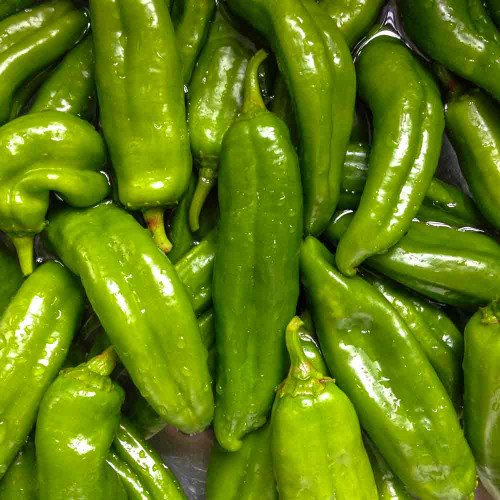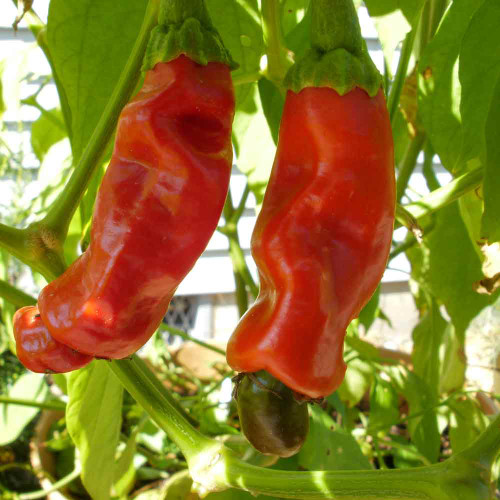Description
Espelette Pepper - Taste the Basque Country in Your Garden
The Espelette pepper has certainly earned its legendary status by consistently proving itself to be exceptional. This treasured chile of the Basque country is renowned for its robust and slightly smoky flavor, which is celebrated in art, cuisine, and festivals. In the Basque Country, the Espelette pepper has become a cultural and culinary icon, achieving controlled-name status, a tribute to its unique qualities and heritage.
To be known as "Piment d'Espelette," the chile must be grown, harvested, and dried according to specific cultural traditions around Espelette. Our original seed stock came from the Espelette region, and is grown in the U.S. by one of our experienced, professional growers.
Known by several names, including Piment d'Espelette in French, Ezpeletako Biperra in the Basque language, and simply Gorria, meaning "red" in Basque, the Espelette pepper takes its name from the community of Espelette in France, its traditional growing region. This truly special pepper is known for its rich history, unique flavor profile, and mild heat level, contributing to its popularity among chefs and home cooks. Relatively easy to grow and compact, Espelette peppers are an excellent choice for home gardeners, thriving even in smaller gardens and containers.
Details
The Espelette pepper is an annual plant, typically reaching a height of 2 to 5 feet with a spread of 18 to 24 inches. Each plant yields an abundance of aromatic peppers, usually between 15 to 30. Decked with small, white, star-shaped flowers, the plants produce elongated, conical pods ranging from 2.75 to 5.5 inches long. These pods can be straight, curved, or slightly concaved. As they ripen, they transform from a vibrant green to a deep, rich red, often with darker areas and occasional green patches near the stem. The glossy, smooth, and lightly wrinkled skin covers semi-thick flesh, giving the pepper a satisfying crunch when bitten into.
What truly sets the Espelette pepper apart is its distinctive flavor once dried and ground into powder. This peppery aroma gives way to a bright, sweet, and fruity taste, underscored by smoky undertones and hints of citrus. Its mild to medium heat level, ranging from 500 to 4,000 Scoville heat units (SHU), puts it on the lower end of the Scoville scale, making it a delightful choice for those who prefer less fiery flavors.
Grow these exceptional peppers in full sun, ensuring they receive at least 6-8 hours of direct sunlight daily. Well-drained, moderately fertile soil is ideal, and consistent moisture is essential. However, avoid overwatering, which can lead to root rot. While they are short-lived perennials in USDA Hardiness Zones 10-12 in cooler climates, they are typically grown as annuals or overwintered indoors.
History
While the Espelette pepper's origins lie in Central and South America, its journey to fame began in 1523 when Gonzalo Percaztegi, a Basque navigator who sailed with Christopher Columbus, introduced this landrace variety to the Nive Valley of the Basque region in France. The pepper quickly adapted to its new environment and was initially used for medicinal purposes. Drawn to its captivating aroma, the region's people soon recognized its flavor potential, and it gradually replaced black pepper as their preferred spice.
Over centuries, Basque farmers, particularly women, meticulously cultivated and selected the best seeds for future planting, resulting in the development of the specific variety known as "Gorria." This traditional practice of seed saving and selection has preserved the unique characteristics of the Espelette pepper, ensuring its distinct flavor and aroma.
Uses
The Espelette pepper is a versatile ingredient, both fresh and dried. Fully ripe, mature peppers offer the richest, fullest flavor and aroma. Fresh peppers can be added to sauces, salsas, salads, and stir-fries or cooked down to make pepper jellies, jams, and pastes. Dried peppers are often ground into a powder with a smoky flavor reminiscent of paprika. This powder is used to season various dishes, including soups, stews, eggs, fish, and vegetables. It is also a key ingredient in piperade, a traditional Basque dish made with onions, tomatoes, and peppers. One of the most famous uses of Espelette pepper is in the production of Bayonne ham, which adds a distinctive flavor during curing.
Interestingly, Espelette pepper has been used to flavor chocolate in the Basque region since the 17th century. This unique combination highlights the pepper's versatility and ability to complement sweet and savory flavors.
Companion Planting
Companion planting can be a valuable technique for enhancing the growth and health of Espelette peppers. By strategically placing certain plants nearby, you can create a mutually beneficial environment that deters pests, improves soil conditions, and even enhances the peppers' flavor.
Basil, cilantro, onions, and chives are excellent companions for Espelette peppers, as they effectively repel common pests while contributing to a richer flavor profile. Cilantro, in particular, masks the pepper's scent, making it less attractive to unwanted insects and attracting beneficial insects that prey on pests.
Rosemary provides a natural ground cover, helping retain moisture and protecting the pepper plants from harsh elements. Similarly, carrots offer ground cover and suppress weed growth, minimizing competition for nutrients and water. Marigolds are another beneficial companion, suppressing harmful nematodes and attracting beneficial insects.
While tomatoes and Espelette peppers are members of the nightshade family, it's important to rotate crops to prevent the buildup of soilborne diseases. Planting them in different locations each year helps maintain soil health and ensures the continued success of your pepper crop.
Harvest Tips
Harvest Espelette peppers when they are fully ripe and have turned a deep red color for the best flavor. Regular harvesting encourages continued fruit production. Traditionally, Espelette peppers are dried in festoons hung from balconies and house walls, creating a picturesque autumn scene. They can also be dried on wooden racks or using a dehydrator. Once dried, they can be ground into powder or stored whole for later use.
The Espelette pepper, with its unique flavor profile and rich cultural heritage, is truly a treasure of the Basque Country. Whether enjoyed fresh from the garden, dried and strung into festive garlands, or ground into a flavorful powder, it captivates taste buds and inspires creativity in the kitchen.
Learn More
- Growing Peppers 101
- Chile and Pepper Growing Tips
- Grow Better Peppers with Shade
- Fermented Pepper Sauce
- Fermented Chile Paste
From the soil to the seed to the food you eat - we'll help you grow your best garden!
4 Reviews
-
Easy winner for me!
This pepper was not fussy or difficult to grow whatsoever. I had no pest problems and it grew a generous amount of peppers. I picked and dried them and they pulverized. We used it and added it to cheeses. Gave an excellent smoky flavor!
-
A Gem :-)
These grew very well in my community garden plot, with little attention beside soil prep at the start. I found them really versatile, with a balanced flavor and no bitterness as some peppers have. Mine were about as hot as a jalepeno. Added them to stir fries and soups, and fridge pickles and they were wonderful.
-
Espelette/ Basque Hot Pepper Seeds
I gave a 5 star rating because the germination rate was very good. Unfortunately, the seedlings must have been delicious. I came home from work one night and the cat had eaten the tops off every seedling. These were the only plants he even got near. I will try again next year.
-
A big harvest
This grew very well in a hot dry summer. The skin was tough and the flesh thin. I think this would be a pepper best for drying and grinding into powder. It was not my favorite fresh pepper due to the toughness, but it did have a good flavor and hotness that one expects out of a hot pepper. The plants also get a bit taller than the other peppers in the patch, so put this one in the back of the garden. Another plus was a big harvest and it had no pest issues.

















